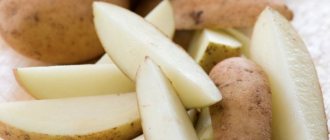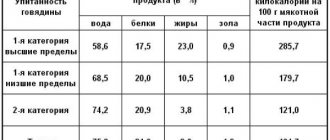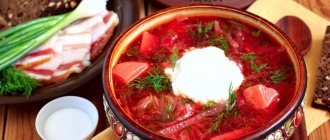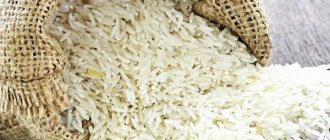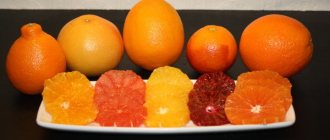Like other vegetables, bell peppers have a large number of useful elements in their chemical composition. Each of them is important for the proper functioning of the body as a whole and its individual systems in particular.
In this regard, a vegetable is one of the most nutritious foods, so it is useful in a person’s daily diet. And its low calorie content makes it an indispensable product in dietetics.
Chemical composition of the vegetable
Considering its composition, bell pepper can be called a unique vegetable:
| Vitamins, macro- and microelements | Main beneficial properties |
| Retinol | Good for vision, is a good antioxidant. |
| A nicotinic acid | Supports proper functioning of the heart and blood vessels, regulates cholesterol levels in the blood. |
| Ascorbic acid | Increases the body's defenses. |
| B vitamins | Regulate the functioning of the nervous system, have a beneficial effect on memory, and increase stress resistance. |
| Tocopherol | Promotes rejuvenation and stimulates tissue regeneration. |
| Phylloquinone | Regulates the process of blood clotting, promotes bone tissue restoration and participates in calcium metabolism. |
| Beta carotene | One of the most powerful antioxidants. Has a beneficial effect on the visual system and immunity. |
| Potassium | Removes excess salt, prevents the development of sclerosis. |
| Calcium | Plays an important role in the transmission of nerve impulses and is an integral part of bone tissue. |
| Phosphorus | Useful for the proper functioning of cells. |
| Magnesium | Involved in the distribution of calcium and participates in the formation of bone tissue, supports the functioning of the heart and blood vessels. |
| Sodium | Takes part in the transmission of nerve impulses. |
| Iron | It is an important substance for maintaining the level of hemoglobin in the blood and takes part in gas exchange processes taking place in cells. |
| Copper | Participates in the production of red blood cells, helps maintain stable functioning of the immune system. |
| Manganese | Regulates blood glucose levels. |
| Selenium | Good for the myocardium. |
| Zinc | Increases the body's protective functions and accelerates tissue regeneration. |
Bell pepper has several varieties; the actual presence of certain substances may differ from the list presented. This also changes the calorie content of the product slightly.
The nutritional value
Bell peppers are a unique combination of excellent taste, amazing aroma, crunchy texture, minimal calorie content and a lot of beneficial properties. Despite the fact that fruits of different colors differ somewhat in their chemical composition, taste and calorie content, each of them is beneficial for the body in its own way. So, red ones have 10 times more β-carotene and 1.5 times more vitamin C than green ones. But green ones contain the optimal amount of capsaicin, and yellow ones are the best natural antidepressant. In general, it is best to include different colored fruits in your diet to get the most benefits from them.
The composition of such vegetables of all varieties includes:
- 91% water;
- 2% fiber;
- 0.1% organic acids;
- 4.8% mono- and disaccharides.
They are also an excellent source of phytonutrients, which include cinnamic and ferulic acid, as well as a number of flavonoids - quercetin, luteolin, hesperidin. The most famous phytonutrients in the composition are carotenoids - alpha and beta carotene, lutein, zeaxanthin and cryptoxanthin.
Proteins fats carbohydrates
The composition of bell pepper BJU varies slightly within the following limits (per 100 grams of product):
- proteins - 1.0–1.3 g;
- fats - 0.1–0.3 g;
- carbohydrates - 6.9–7.4 g (of which 2 g dietary fiber and 4.8 g saccharides).
Almost 5% saccharides with a virtual absence of organic acids provide the characteristic sweet taste of the fruit without the slightest sourness. At the same time, the maximum amount of carbohydrates is contained in red and yellow fruits, and the least in green fruits, which is primarily confirmed by their taste.
Macro- and microelements
The mineral composition of sweet, aromatic vegetables includes a wide range of macro- and microelements. The greatest quantities are present:
- potassium and sodium - the quality of functioning of muscle tissue and nerves, regulation of water-salt metabolism, and maintaining an optimal state of the acid-base environment depend on the correct potassium-sodium balance;
- phosphorus - almost completely (90%) is concentrated in bone and dental tissue, and the remaining 10% is distributed throughout the body and participates in the life of all cells;
- calcium - participates in the processes of contraction of muscle tissue, excitability of nerve fibers, regulation of blood clotting, has anti-allergic and anti-inflammatory effects, activates a number of hormones and enzymes;
- magnesium - activates enzymatic reactions, plays a major role in protein synthesis, ensures proper muscle function, including the heart, and the full functioning of the nervous system;
- iron - directly affects the formation of hemoglobin, protects against bacteria, strengthens the immune system, participates in the synthesis of thyroid hormones, ensures the full functioning of B vitamins;
- manganese - promotes cell development, eliminates the consequences of poisoning, improves digestion and central nervous system function, reduces nervous irritation, normalizes glucose and cholesterol levels, restores cartilage tissue, activates enzymes, participates in the formation of the main thyroid hormone - thyroxine;
- copper is an indispensable component of the oxidation of enzymatic systems, promotes the normal course of biochemical processes, improves metabolism and redox reactions;
- zinc - affects the functioning of the brain and the entire nervous system, strengthens protective functions, activates the process of hematopoiesis and the synthesis of digestive enzymes, and is necessary for the secretion of almost all hormones.
To get the full benefit from this composition, it is recommended to consume the sweet Bulgarian “berry” raw. For the best preservation of valuable properties, if necessary, the fruits can be frozen or dried and later used as a seasoning.
Vitamins
Pepper contains up to 30 types of different vitamins, but in the greatest quantities it contains the most valuable antioxidants - vitamins A, C, E, as well as group B. It is this vegetable crop that is the record holder for the content of ascorbic acid (vitamin C), and to satisfy the daily requirement The requirement for this element is enough to use 2-3 pieces, depending on the size.
The vitamin C content is a varietal characteristic and can vary from 270 to 330 mg. At the same time, fruits of technical ripeness (when they have gained mass, but have not yet acquired their varietal color) contain less of this vitamin and saccharides than fruits of biological ripeness (finally ripe).
Important! To prevent the loss of a significant portion of vitamin C, sweet bell peppers must not only be consumed raw, but also handled correctly. It is known that the main amount of ascorbic acid is concentrated around the stalk, so during cleaning it is not recommended to cut off the top too much.
The beneficial properties of these vegetables are determined by the actions of these and other vitamins present in them:
- C - allows for better absorption of incoming iron, stimulates liver function, actively participates in redox reactions, improves the synthesis of thyroid hormones, strengthens the immune system, accelerates wound healing, improves the condition of all tissues;
- A − ensures the normal course of redox processes and protein synthesis, is a powerful antioxidant, helps maintain the youth of all organs and systems;
- E - significantly slows down aging, stimulates the immune system, protects against viruses and bacteria, accelerates tissue regeneration, improves vascular tone, activates blood circulation, participates in the production of hormones, increases the body’s regenerative abilities;
- K − eliminates bone loss after fractures, increases bone mass, reduces arterial calcification, reduces the risk of ischemia and the development of cancer, helps maintain youthful skin, preventing age-related loss of collagen;
- groups B (B1−B3, B5, B6, B9) - help extract energy from food, strengthen the nervous system, increase thinking abilities, and participate in all metabolic processes.
The minimum calorie content of bell pepper and the universal multivitamin complex it contains make it an excellent preventive and therapeutic remedy for vitamin deficiency, especially while on a diet. Moreover, to achieve sustainable weight loss, you don’t have to resort to extreme measures. It is enough to give up high-calorie dishes and replace them with salads, the main component of which will be healthy and tasty bell pepper.
Health benefits of pepper
No product is a magic cure that will cure all diseases. But with regular use, you can count on a positive result, albeit small.
As for bell pepper, it has the following beneficial properties:
- reduces the risk of developing anemia;
- prevents the formation of cancer cells;
- improves eye health;
- has a positive effect on mood;
- helps strengthen the immune system;
- helps reduce weight;
- has a beneficial effect on the quality and growth of hair, the condition of the skin and nails;
- reduces the level of bad cholesterol in the blood;
- removes toxins from the lungs;
- improves memory and reduces absent-mindedness;
- has an antibacterial effect on the digestive system;
- has a beneficial effect on the body of a pregnant woman and the development of the fetus.
Eating it on a regular basis will help restore proper functioning of the body and prevent the development of pathologies. This vegetable, like most others, is recommended to be consumed raw, since when cooked it loses more nutrients.
The ability of bell pepper to resist anemia is due to the presence of iron in its chemical composition, and the formation of cancer cells due to powerful antioxidants. In addition, it contains another substance that also reduces the risk of developing tumors.
Vitamins of group B, as well as P (bioflavonoids) and PP (nicotinic acid) have a beneficial effect on the cardiovascular and nervous system, namely normalize sleep, strengthen memory, increase performance and help fight stress.
Benefits of each type
It is believed that red pepper is the most useful type. It contains the largest amount of antioxidants, and also contains lycopene and rutin. These substances prevent the penetration of carcinogens into cells, accelerate the process of tissue regeneration and promote rejuvenation.
The yellow fruit contains, among other things, xanthophyll, an antioxidant that is a derivative of carotene, which also prevents the degeneration of cells into malignant ones.
Green bell peppers are rich in chlorophyll , a substance that removes free radicals from the body. To get the most benefit from the vegetable, it is recommended to consume different types of fruits.
Composition of bell pepper:
Vitamins:
| Vitamin: | WITH | IN 1 | AT 2 | AT 4 | AT 5 | AT 6 | RR | A |
| in mg. per 100 grams | 150.0 | 0.06 | 0.1 | 5.5 | 0.099 | 0.35 | 0.6 | 250.0 |
Minerals:
| Mineral: | Calcium | Phosphorus | Magnesium | Potassium |
| in mg. per 100 grams | 8 | 16 | 7 | 163 |
Sweet pepper will be good for insomnia, depression and stress, and memory problems. It is useful for those suffering from dermatitis, edema and diabetes. Regular consumption of this vegetable helps strengthen the walls of blood vessels. Thanks to a rich set of useful chemical elements, it is very useful for anemia, lack of vitamins, and “failures” in the functioning of the sebaceous and sweat glands.
There is no doubt about the benefits of sweet pepper for the gastrointestinal tract; it stimulates appetite and promotes the functioning of the pancreas and stomach.
It reduces blood pressure and helps thin the blood, preventing blood clots from forming.
Possible side effects
Along with its positive properties, bell pepper can also have a negative effect on the human body. More precisely, it can be used by everyone, unless the attending physician prohibits it.
However, the amount should be limited for the following diagnosed diseases:
- gastritis with high acidity and stomach ulcers;
- hypertension in acute or chronic course;
- ischemia;
- impaired renal and liver function.
This is due to the fact that bell pepper contains the alkaloid capsaicin, which irritates the walls of the stomach, and the effect on blood pressure makes regular use impossible for hypertension at any stage of its course. It is also important that the vegetable contains essential oils that contribute to the development of an allergic reaction, which can result in individual intolerance.
Use during pregnancy
Many pregnant women are wary of most foods, fearing that it will negatively affect the development of the fetus. However, during this period you can eat bell pepper, but within reason, that is, do not overeat. The only recommendation is that this vegetable, like others, should be consumed in season. The rest of the time, there is a high probability of buying a product filled with harmful substances.
Calories and nutritional value
Red, yellow and green peppers either have no differences at all in chemical composition and calorie content, or these differences are insignificant:
| Treatment | Calories (red/yellow/green) |
| Fresh (100 g) | 26,95/ 27,09/ 26,00 |
| Fresh (1 piece, weight approximately 200 g) | 53,9/ 54,18/ 52,00 |
| Marinated | On average 25 kcal per 100 g |
| Dried | On average 282 kcal per 100 g |
| Boiled | On average 28 kcal per 100 g |
White and black pepper
Along with the Bulgarian vegetable, white and black pepper are widely used. It is used in peas or ground form for preparing fish and meat dishes, pates, and salads.
100 g of ground white pepper contains approximately 296 kcal, as well as phosphorus, potassium, zinc, sodium, calcium, iron, B vitamins and minerals.
The spice has an antiseptic, anthelmintic and astringent antifungal effect, improves the digestion process and removes toxins. To achieve the effect, it is enough to eat 1-2 peas a day.
Pepper has a beneficial effect on the nervous and cardiovascular systems, improves immunity, freshens breath and is used to make anti-inflammatory and warming ointments.
Per 100 g of ground black pepper there are 251 kcal: proteins - 10.4 g, fats - 3.3 g, carbohydrates - 38.7 g. It contains 1-2% essential oils and 5-9% piperine alkaloid, which causes a bitter-burning taste and specific aroma. Ground black pepper has a beneficial effect on blood circulation and digestion, and normalizes metabolism.
BJU containing different types of pepper
The amount of proteins, fats and carbohydrates contained in bell peppers of different types is also not very different:
| (g/ 100 g product) | Red | Yellow | Green |
| Squirrels | 1,30 | 1,25 | 1,30 |
| Fats | 0,00 | 0,05 | 0,00 |
| Carbohydrates | 5,53 | 5,33 | 5,43 |
To calculate the BJU of one fruit, the figures presented in the table should be multiplied by 2, since on average it weighs 200 g.
What is the difference between the caloric content of red peppers and green or yellow ones?
The calorie content of the product also depends on its color. Thus, a yellow vegetable contains approximately 3 kcal more than a red fruit. Differences in caloric content are explained by different amounts of nutrients in the composition.
Green peppers are considered the lowest calorie type due to their minimal carbohydrate content.
For this reason, the unripe fruits of the plant have a slightly bitter taste. But yellow and red fruits lead in the amount of sugar in their composition, so they are valued for their energy value.
Also, vegetables of different degrees of maturity differ in the content of minerals, vitamins and other substances necessary for the normal functioning of the body. Green fruits are rich in capsaicin, a substance that stimulates appetite and improves the condition of the gastrointestinal tract. It is capsaicin that gives green peppers their characteristic bitter taste. The yellow vegetable contains a large amount of pectin, rutin and fiber, and the red vegetable contains vitamin C and beta-carotene.
Bell pepper and weight loss
Bell pepper has a low calorie content, so it is excellent for feeding people with diabetes, as well as people who adhere to a diet, including a strict low-carbohydrate diet. Despite the fact that it is a fairly light product, bell pepper gives the body energy that lasts for a long time, thereby suppressing appetite.
This vegetable perfectly removes waste and toxins. The bell pepper diet is aimed mainly at breaking down fat deposits and eliminating swelling. Those who adhered to such a nutrition system noted its high efficiency. However, there are a number of rules that must be followed to achieve the desired result.
General recommendations:
- When choosing fruits, you should pay attention to appearance. The tail of the pepper should be elastic and green, the surface should be free of dents, wrinkles and other damage, smooth, and the flesh should be elastic.
- The bell pepper diet can last a maximum of 2 weeks, after which you should switch to a more varied diet.
- A significant part of the menu is pepper. It is advisable to buy yellow or red - they are best suited for the diet, taking into account the nutritional value and calorie content.
- Harmful foods should be completely excluded from the diet. These include smoked foods, pickles, sweets, flour, spicy, fatty foods, alcohol, fast food, and carbonated sweet drinks. It is recommended to limit salt intake as much as possible.
- Additionally, it is recommended to include other vegetables and fruits in your diet. Only bananas, potatoes and grapes are undesirable for consumption, as they contain a lot of calories. In addition, you should eat mushrooms, lean meats and fish, dairy products and eggs.
- You need to drink at least 2 liters of water per day. Drink the first glass immediately after waking up. For drinks, you should give preference to green tea and rosehip decoction, but it is better to avoid coffee during the diet. Or at least limit its consumption to one cup every 2-3 days.
- No matter how paradoxical it may sound, it is also better to refuse active physical activity. However, you can find easier alternatives, such as walking in the evening before bed. This is due to the fact that the diet is not able to maintain energy balance during excessive physical activity.
- The last meal is taken 4 hours before bedtime.
Quitting the diet
The right output affects the result no less than the diet itself. If you immediately return to your usual diet, namely, start consuming unhealthy foods in large quantities, the lost weight will return.
During the first days, it is recommended to gradually include in the diet the foods that were prohibited. Smoked, sweet, salty and fatty foods can be consumed, but in minimal quantities.
It is better to stew, bake or boil dishes, and eat vegetables and fruits fresh and in large quantities. For sweets, give preference to marshmallows, marshmallows and marmalade. The diet should be balanced and rich in protein.
Use in dietetics
Bell pepper, whose calorie content is very low, formed the basis of the nutrition system. The diet is relatively varied, although for some people it may seem complex and monotonous.
An example of a low-calorie daily menu based on bell peppers
It is quite possible to follow the diet below. It is designed for 2 weeks, although it can be shortened at your discretion. The main thing is not to break down. If this happens, you need to take a 10-day break and then resume.
Sample menu:
| Day | Meal plan |
| 1st | Prepare 500 g of bell pepper and the same amount of any other vegetables in the preferred way: stew, steam or grill. You can leave them all fresh or only part of them, and heat treat the rest. The resulting amount is divided into 5 equal meals. Eat throughout the day, taking breaks of 2 hours. At the same time, do not forget about water, decoctions and teas. |
| 2nd | The rules and quantity of products remain the same as for day 1, only instead of various vegetables, fruits are consumed along with pepper. |
| 3-1 and 4th | For each day, 300 g of bell pepper and fruit are calculated, which are divided into 3 meals. For breakfast, eat 100 g of pepper and fruit, 1 boiled egg and drink a cup of green tea. The next meal is lunch, and then dinner. In each of them eat 100 g of pepper and fruit. |
| 5th – 7th | For breakfast – a mug of green tea with lemon, lunch – 300 g of pepper, lunch – 200 g of lean meat, afternoon snack – 200 g of low-fat cottage cheese, dinner – a mug of kefir. |
| 8th | The diet of 1 day of the diet is repeated. |
| 9 — 10 | The diet of days 3 and 4 of the diet is repeated. |
| 11- 14 | The diet is repeated for 5, 6 and 7 days of the diet. |
If the condition worsens, a feeling of weakness and other unpleasant symptoms appear, it is better to abandon such a diet and return to a balanced diet.
Low-calorie recipes with bell peppers
The vegetable is a common ingredient in many low-calorie cooking dishes that will help get your body in shape.
Cream soup
Cream soup based on fried peppers is a tender and tasty dish that satisfies your appetite and does not contribute to weight gain.
To prepare it you need to take:
- Broth (chicken) – 1 l.
- Sweet red pepper – 4 pcs.
- Cauliflower – 1 pc.
- Onions – 1 pc.
- Coarsely ground chili – ½ tsp.
- Paprika – 1 tsp. l.
- Garlic – 1-2 cloves.
- Vegetable oil – 1 tbsp. l.
- Thyme – 1 tsp. l.
- Cheese (goat) – 100 g.
- Spices - to taste.
Creamy bell pepper soup
Before you start frying the peppers, you need to wash them, cut them in half and remove the seeds. Vegetables are fried in hot oil for 10 minutes on the inside. Place the fried vegetables in an airtight container for 20 minutes, after which they must be peeled and cut into cubes.
Cauliflower, disassembled into inflorescences, is baked in the oven for half an hour at 200°. At this time, fry the diced onion until soft. Then chopped garlic, thyme and chili are added to it. Next, pepper, cabbage, paprika, broth, goat cheese and spices are added to the mixture. The soup is boiled for 10 minutes, after which it is brought in a blender to a creamy consistency.
Stuffed pepper
This dish is widely popular all over the world.
- Pepper – 3 pcs.
- Rice – 150 g.
- Minced meat – 300 g.
- Onion – 1 pc.
- Garlic – 2 cloves.
- Paprika – 1 pinch.
- Spices - to taste.
Stuffed pepper
To prepare the filling, boil the rice and fry the finely chopped onion and garlic until soft. Minced meat and paprika are added to the onion and fried for 10 minutes. Then rice is added to the minced meat, and the resulting mixture is simmered in a frying pan for a few more minutes. Next, spices are added.
The peppers, from which the tops have been previously removed and the seeds removed, are stuffed with minced meat. The stuffed vegetables are laid out on a baking dish, at the bottom of which it is recommended to pour a little water. Peppers are baked for 15 minutes at a temperature of 220°.
